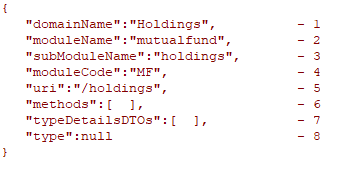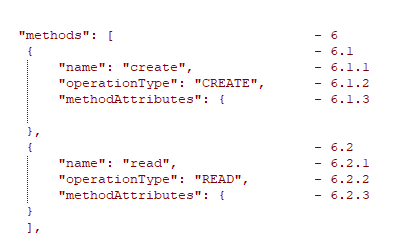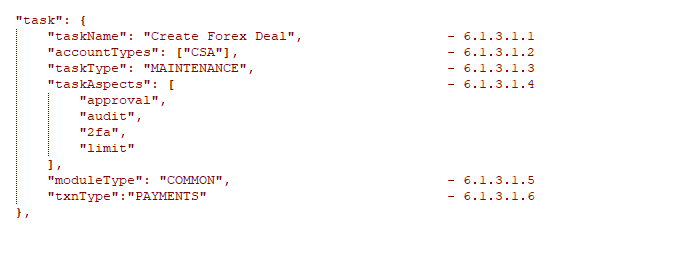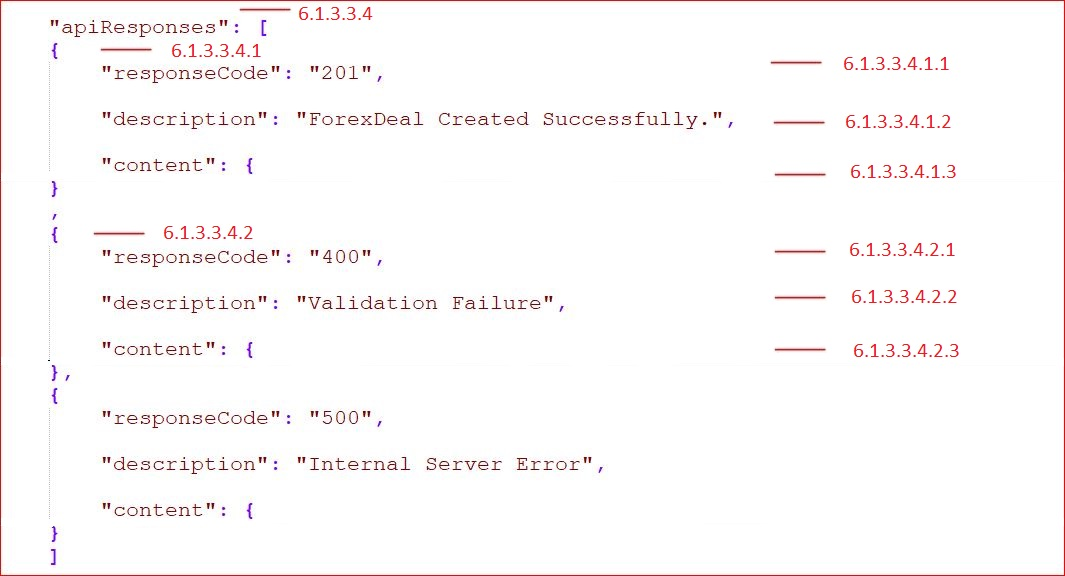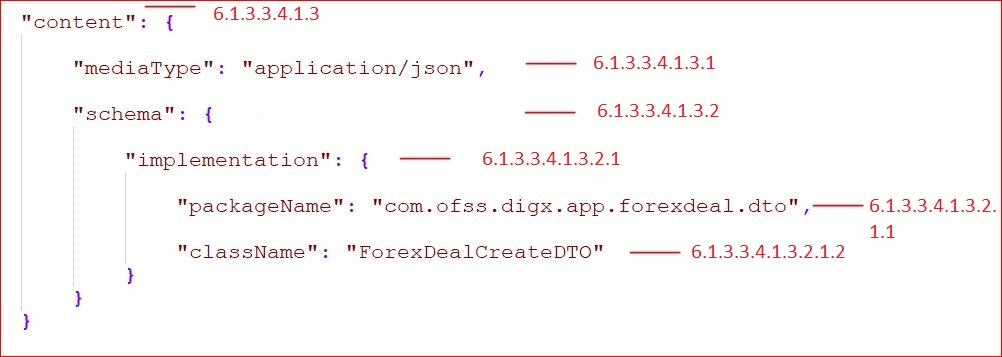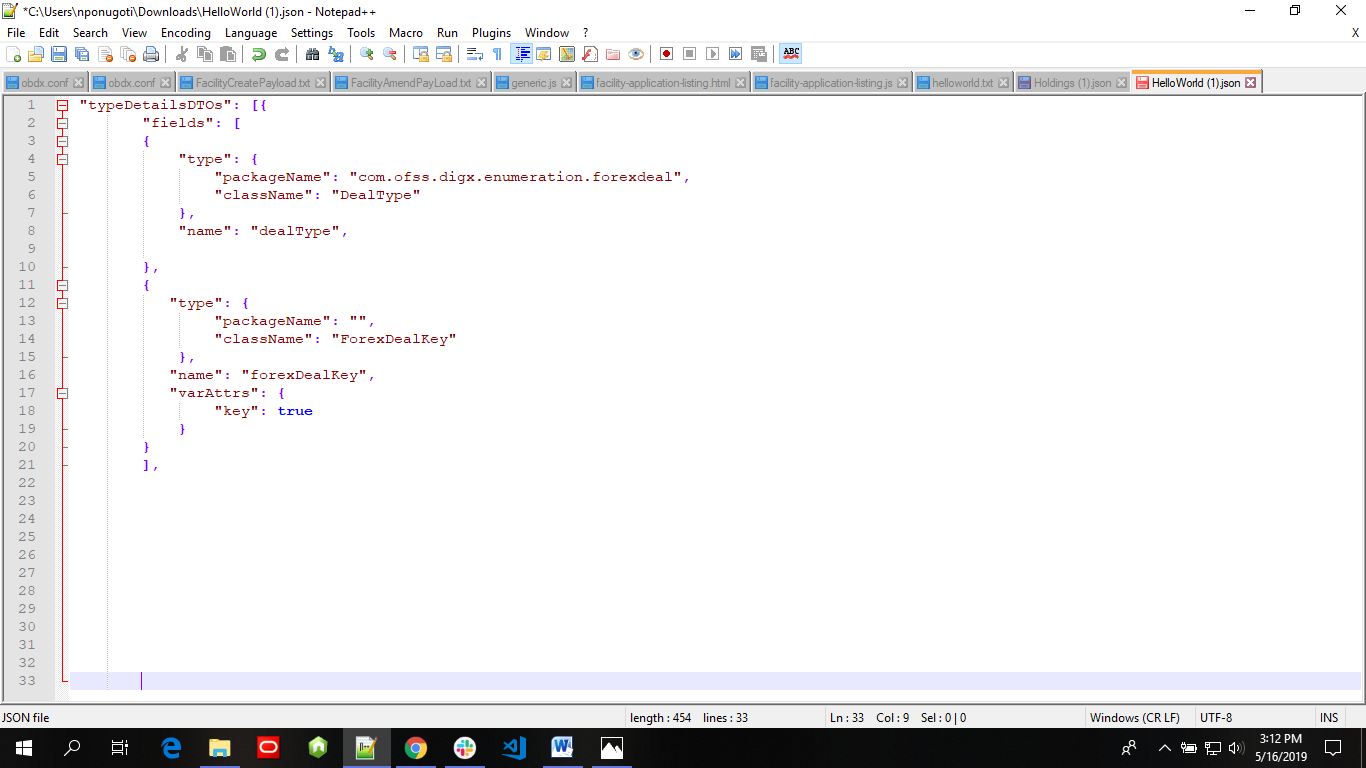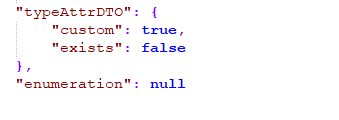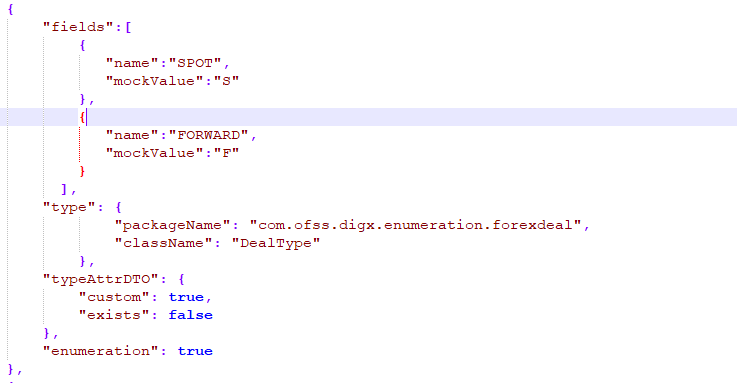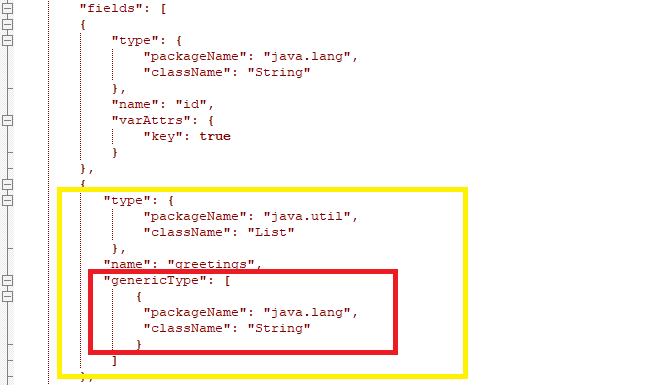5 JSON Explained
User should prepare the JSON with right set of values of the keys/nodes. A sample JSON is depicted below in the figure. The JSON is set with sample values for a mutual fund holdings functionality under payments. As part of the explanation, some of the JSON nodes or fields or keys may differ from the sample JSON provided (It has been done to explain functionalities which cannot be covered using just sample JSON) . Each and every key/node of the JSON is explained below:
- domainName(*): User has to input the name of the domain entity which represents one business use case. e.g. Holdings i.e. mutual fund holdings is a domain( a business use case under payment transactions)
- moduleName(*): User should provide the name of the module to
which this domain functionality belongs to.eg. Holdings domain belongs to
“mutualfund” module.
- subModuleName: It is common to have module constituting of
sub-modules. User should set the appropriate name of the sub-module (depending
upon the domain functionality).
- moduleCode(*): It is basically an abbreviated unique
identifier of the module to which the service belongs . It is formed by taking
the initials of the module name. “moduleCode” has to be decided by theuser. Here
“MF” is formed by taking initials of the “mutualfund” module.
Here “MF” is formed by taking initials of the “mutualfund” module.
- uri(*):It is the path of the REST resource. It is the path
exposed to the end user, of the product channel (as REST API). This is the URI
which will appear in the swagger JSON created using the tool.
This is the URI which will appear in the swagger JSON created using the tool.
- methods(*): User should provide the methods which are
expected in the domain. A combination of “name” and “operationType” nodes
uniquely defines a method. The “methods” node is an array of methods defined in
the domain. Part of the JSON depicting methods is presented below:
- name(*): User should provide the name of the methods. A method name depicts the operation that the user wants to perform by calling this method. For example
- operationType(*) : Operation type is synonymous to REST operation type. So the method with operationType ‘CREATE’ will result in creation of a new resource at the specified URL (similar to what REST “POST” operation does).
User must provide the functionality the method is going to perform. It should be one of the following list of strings: ‘CREATE’, ‘READ’, ‘UPDATE’.
If the method performs creation task it should have operation type as “CREATE”.
- methodAttributes: Method or Operation defined in the
application carries various properties which defines its behavior. For example
an operation or a method can go for approval. In order to ensure that the
declared method has the property to go through approval process the task aspects
of the task attribute must have a value “approval”. These properties which
attaches various behaviors to the application, facilitates various application
requirements such as swagger UI generation, etc. are taken as input by the
Toolkit in the form of “methodAttributes”.
It has various attributes such as ‘task’, ‘entitlements’, ‘swaggerAnnotations’, ‘allocation’
User should provide various attributes of the methods such as tasks associated with them, entitlements allocated to them and swagger details.
- task: User should provide the details of the task associated
with the method
- taskName: User should declare name of the task associated with the current method
- accountTypes: User should provide the supported account types
by the current transacting method. The set of all possible values that a user
can provide are given below in the table with its
description:
For detailed values to be input in the “accountTypes” please refer below table:
Sr. No. Account Types Description 1 CSA “CSA" refers current and savings accounts 2 LON "LON" refers loan accounts 3 TRD "TRD" refers term Deposits 4 CCA "CCA" refers Credit card accounts - taskType: User should provide the type of the transaction
that this method will be using. It can be a maintenance transaction or can be an
auth-admin transaction, etc.
The set of possible values that a user can provide is given below in the table:
Sr. No. TaskType Description 1 FINANCIAL TRANSACTION Transactions involving account and amount i.e. monetary transactions 2 NONFINANCIAL TRANSACTION Transactions involving no monetary value. For e.g. Request a cheque book 3 INQUIRY Inquiry of transactions 4 ADMINISTRATION ADMINISTRATION 5 MAINTENANCE MAINTENANCE 6 COMMON COMMON - taskAspects: User should provide the details of the aspects
of the transaction associated with the current method. An aspect of the
transaction defines a feature inherently provided by the framework. For example
“approval” is feature of the transaction which it is going to need while
execution. Similarly, there are various features like limit, two-factor
authentication(2fa), audit, etc. which the transaction can be dependent upon
(based on use case of the
transaction).
The set of possible values that taskAspects can carry are :
Sr. No. TaskAspects Description 1 limit Applicability of limits for a transaction 2 account-access Applicability of access for a transaction 3 approval Applicability of approval rules for a transaction 4 working-window Applicability of working window i.e. cutoff for a transaction 5 blackout Applicability of blackout or outage for a transaction 6 2fa Applicability of two factor authentication for a transaction 7 audit Applicability of audit log for a transaction 8 grace-period Applicability of grace period for a transaction 9 eReceipt Applicability of e-Receipt for a transaction 10 purpose-mapping Applicability of purpose mapping to transaction 11 currency-config Applicability of currency mapping to transaction 12 account-relationship Applicability of access on the basis of account relationships - moduleType: User should provide the type of the module.
Type of the module are :
Sr. No. moduleType Description 1 TD TERM_DEPOSIT 2 CH CASA 3 PI PARTY 4 LN LOAN 5 OR ORIGINATION 6 PC PAYMENTS 7 AT CHANNELS 8 CC CREDIT_CARD 9 SMS SMS 10 FL FINANCIAL_LIMITS 11 WA WALLET 12 BO BACK_OFFICE 13 FU FILE_UPLOAD 14 AP APPROVALS 15 NM NOMINEE 16 AL ALERTS 17 PFM PFM 18 RT REPORTS 19 LC LETTEROFCREDIT 20 BL BILL 21 CM COMMON 22 BM BENEFICIARYMAINTAINANCE 23 GR GENERICREST 24 MT ADMIN_MAINTENANCE 25 FX FOREXDEAL 26 MB MOBILE - txn type: User should provide the type of the transaction
- entitlements:
Entitlements are meant to group transactions. Transactions can be grouped into categories and further into sub-categories.
For example a user onboarding transaction can be grouped into “Admin Maintenance” category and further into “User Management” sub-category. User should provide the details of category into which the currently executing method can be grouped with a further sub-category level grouping. e.g.
There is a list of groups and sub groups provided in the table below.
Sr. No. Entitlement Category Description 1 MT Entitlement Category constant for 'ADMIN MAINTENANCE' 2 RP Entitlement Category constant for 'REPORTS' 3 CS Entitlement Category constant for 'CUSTOMER SERVICING'. 4 CASA Entitlement Category constant for 'CURRENT SAVING ACCOUNT' 5 TD Entitlement Category constant for 'TERM DEPOSIT' 6 LN Entitlement Category constant for 'LOAN' 7 PC Entitlement Category constant for 'PAYMENTS' 8 FU Entitlement Category constant for 'FILE UPLOAD 9 TF Entitlement Category constant for 'CREDIT CARDS' 10 CC Entitlement Category constant for 'CREDIT CARDS' 11 PFM Entitlement Category constant for 'PERSONAL FIANANCE MANAGEMENT' 12 FX Entitlement Category constant for 'FOREX'. 13 EBP Entitlement Category constant for 'ELECTRONIC BILL PAYMENT' 14 MB Entitlement Category constant for 'MOBILE APP MAINTENANCE' 15 PRL Entitlement Category constant for 'PRE LOGIN' 16 OR Entitlement Category constant for 'Originations' 17 ENUMP Entitlement Category constant for 'ENUMERATION' 18 AUTH Entitlement Category constant for Authentication If there are no groups or sub-groups into which the current transaction can be put then the user needs to add a new category and sub-category.
Sr. No. Entitlement Category Description 1 SC System Configuration 2 SR System Rules 3 LMD Limits Definition 4 UL User Limits 5 LMP Limits Package 6 TG Task Group 7 SPC Spend Category 8 SPCM Spend Category Maintenance 9 GOC Goal Category 10 PYP Payment Purpose 11 PYR Payee Restrictions 12 BCM Bill Category Maintenance 13 BCMUBS Bill Category Maintenance UBS 14 UM User Management 15 MOB Merchant Onboarding 16 AUTH Authentication 17 MSS Manage Security Settings 18 PPL Password Policy 19 TXB Transaction Blackout 20 WW Working Window 21 UGSM User Group Subject Mapping 22 UGM User Group Management 23 ALM Alert Maintenance 24 BR Brand Management 25 DSHBD Dashboard Management 26 AL Audit Log 27 AUL Audit Logging 28 ABM ATM Branch Maintenance 29 PDM Product Mapping 30 ML Mailers 31 MGB Manage Brands 32 TXA Transaction Aspects 33 PPI Password Print Information 34 OWC Origination Workflow Configuration 35 PL Party to Party Linkage 36 PAC Party Account Access 37 UAC User Account Access 38 LUAC Linked User Account Access 39 LPAC Linked Party Account Access 40 FIM File Identifier Maintenance 41 UFIM User FI Mapping 42 AWC Approvals Workflow Configuration 43 SVR Service Request 44 PP Party Preference 45 RM Rule Management 46 URM User Report Mapping 47 RPM Reports 48 RPV Reports View 49 RPC Corp Admin Reports 50 RPU User Reports 51 MN Mailbox Notifications 52 MAIL Mails 53 ALT Alerts 54 NO Notification 55 PF Profile 56 SS Session Summary 57 LOC ATM Branch Locator 58 SCS Security Setting 59 HELP Help 60 CSAAD CASA Account Details 61 CSASM CASA Statement 62 CBR Cheque Book 63 DC Debit Card 64 CSACA CASA Calculators 65 TDAD TD Account Details 66 TDSM TD Statement 67 TDTSN TD Transactions 68 TDCA TD Calculators 69 LNAD Loan Account Details 70 LNSM Loan Statement 71 LNTXN Loan Transactions 72 LNCA Loan Calculators 73 CCAD CC Account Details 74 CCSM CC Statement 75 CCTXN CC Transactions 76 PYT Payments Transfers 77 ADPY Adhoc Payment 78 IntPaye Internal Payee 79 DP Domestic Payee 80 DPR Domestic Payer 81 IP International Payee 82 DDP Demand Draft Payee 83 BM Biller Maintenance 84 CBM Customer Biller Maintenance 85 DD Demand Draft 86 BP Bill Payment 87 RMT Remittance 88 UP Upcoming Payments 89 RF Request Funds 90 FT Favorite Transactions 91 PPP Peer To Peer Payee 92 GO Goal 93 SP Spends 94 BD Budget 95 AS Alert Subscription 96 TPC Third Party Consent 97 LM Limits 98 FUTXN File upload transactions 99 FUT File Uploads 100 FUA File Upload 101 TFLOC Letter Of Credit 102 TFLOCA Letter Of Credit Amendment 103 BAC Bills And Collection 104 OWG Outward Guarantee 105 OWGA Outward Guarantee Amendment 106 GL General 107 ACL Activity log 108 PLT Pre Login Transactions 109 SRFB Service Request - Form Builder Sub Category, under category 'Admin Maintenance'. 110 FDM Feedback Maintenance sub category under category 'Admin Maintenance' 111 NM Nominee sub category under category Customer Servicing. 112 FXDB Forex deal booking sub category under category 'Forex'. 113 PMNT Payment maintenance sub category 114 RTM Role Transaction Mapping sub category under category 'Admin Maintenance'. 115 EBR Favorites sub category of EBPP under category 'Electronic Bill Payment'. 116 EBL Bills sub category of EBPP under category 'Electronic Bill Payment'. 117 AGR Favorites sub category of Account Aggregate under category 'Account Aggregation'. 118 EPY Manage Billers sub category of EBPP under category 'Electronic Bill Payment 119 MCL Mobile Client sub category under category 'Mobile Application' 120 BFM Manage Billers sub category of EBPP under category 'Electronic Bill Payment' 121 MSWPIN Manage Sweep-in sub category under category 'Customer Servicing'. 122 FXDM Forex Deal Maintenance sub category under category 'Admin Maintenance'. 123 ARM Account Relationship Mapping sub category under category 'Admin Maintenance'. 124 FAM 2 factor task auth maintenance. 125 ORP Origination products sub category under category 'Pre-Login' 126 ANN Account Nick name sub category under category 'CUSTOMER_SERVICING'. 127 BU Business entities sub category under category 'CUSTOMER_SERVICING'. 128 ACPU Access Point sub category under category 'CUSTOMER_SERVICING'. 129 FR Fund Request sub category under category 'PAYMENTS'. 130 ANUM Enumeration sub category under category Enumeration. 131 FCL FATCA Compliance sub category under category 'CUSTOMER_SERVICING' 132 FDB Feedback sub category under category 'CUSTOMER_SERVICING'. 133 SAD Service Advisor sub category under category 'CUSTOMER_SERVICING' 134 ORC Origination sub category under category 'Originations'. 135 AP Approvals sub category under category 'CUSTOMER_SERVICING'. 136 ACPM Access Point Maintenance sub category under category 'CUSTOMER_SERVICING'. 137 HDS Help Desk Session sub category under category 'Admin Maintenance'. 138 APA Access Point Account Access under category 'CUSTOMER_SERVICING'. 139 SECQUE Security Question 140 TASK Task 141 SB SMS Banking 142 SRFL Service Request - Form Listing Sub Category, under category 'Customer Servicing'. 143 UPS Preferences of the user. 144 BC Base Configuration 145 FUFT File Upload Funds Transfer. 146 FUP File Upload Payee 147 GR Generic Rest If there are no groups or sub-groups into which the current transaction can be put then the user needs to add the new category and sub-category. Guide to add new categories and sub-categories can be found here.
- swaggerAnnotations:
User should provide the details required for the swagger specification. In swagger documentation for each path(@path Annotation in REST) multiple operations(HTTP methods) can be defined . Swagger defines a unique operation as a combination of a path and an HTTP method. For each operation(HTTP method) there is a summary section and details section in the documentation. On clicking the operation box in swagger one can get details section. The details section consists of description, parameters, request body and responses. Further swagger details can be found here.
“swaggerAnnotations” takes the values relevant for generating the required swagger document. It takes summary, description, tags and API responses. e.g.
- summary: The value input in this field appears in the operation summary of the swagger documentation. The required content in the summary section for the current method(i.e. REST resource or REST URL + ) should be provided here.
- description: User should provide the description of the method(i.e. REST resource).
- tags: Swagger uses tags to group the displayed operations. User should provide the relevant details of grouping and its description.
- apiResponses: For the current API operation all the possible
responses are listed here. e.g.
- responseCode: Response code or HTTP status code of the REST response should be
provided by the user.
e.g. ”201” - if the request has been fulfilled and has resulted in one or more new resources being created. “400” – if the server cannot or will not process the request due to something that is perceived to be a client error.
- description: Description of the http response should be provided here.
- content: It consists of mainly two things mediaType and schema.
- MediaType: User should provide what media type the REST resource
produces.
e.g. “application/json” for JSON,
“application/xml” for XML.
The “content” node of the input JSON is depicted below in the image:
- schema: It is used to describe the REST response body of the respective method. It can define an object or a primitive data type (for plain text responses) or a file. For the object or primitive data type in the response user must provide its packageName and className.
- allocationTiers: User should provide the details of the tiers (REST,
SERVICE, DOMAIN, REPOSITORY) in which the method should be present. It is not a
mandatory field. By default the method is created in all of the tiers
e.g.
- MutualFunds typeDetailsDTOs:
TypeDetailsDTOs array consists of multiple elements representing any Java type (i.e Class or Interface or enumeration) . Each element has child nodes “fields”, “type”, “typeAttrDTO” and “enumeration”.
- fields(*):
All the variables which user intends to declare in the domain are taken care of by this node/key. This node/key stands for the Java type (i.e. Class or Interface or enumeration) or variables or fields to be used in the domain (here ForexDeal) and its required details. This node has further child nodes “type” i.e. Java type for variable, “attrs” for attributes of the Java type or variable or field and “detailsDTO” for other details of the Java type or variables or fields. Other details are provided in case the field is in itself is a type containing further fields. Part of the JSON carrying the sample values of this node is depicted below:
- type(*): “type” here is the Java type(Class or Interface or enumeration)
which takes the qualified name (i.e package name and class name) as input. It
consists of further child nodes depicted below:
- packageName: User should provide the package name of the variable to be declared. It must be left empty if the variable is a domain key
- className: User must provide the class name of the variable to bedeclared
- name(*): User should provide the reference of the variable at
this node/key as can be seen in thefigure.
e.g.
- varAttrs : A variable declared can be an amount, account, party,
queryParam or key of the domain and the corresponding attribute has to marked as
‘true’.
- key: In a domain there is key which is a unique identifier for each domain object. User must provide this key value as “true” if this field is the key of the domain and “false” in case it is a normal variable.
- A key can be a composite key i.e. multiple fields combined
together to form key. In case of composite key user must provide the
“key” attributes as true for all those fields which forms the composite
key.
- amount: User must provide this amount value as “true” if a particular field represents an amount.
- account: User must provide this attribute as “true” if a particular field represents an amount.
- queryParam: Query Parameter is used to sort/filter a specific resource. This variable attribute is marked as “true” if it represents a query parameter.
- party: User must provide this attribute as “true” if a particular field represents a party.
- type: ‘type’ is another node of typeDetailsDTOs. It is again the Java type(Class or Interface or enumeration) which takes the qualified name (i.e package name and class name) of the custom domain as an input.
- typeAttrDTO: A variable can be a Java class of an API or can be a user
defined class. If it is a user defined class or custom class it is possible that
it is an existing domain or variable.
- custom: A declared field can be a Java type (Class or Interface)
which is not a class of existing Java packages instead are defined by
the user. Those user defined fields are custom fields. e.g String class
is a class of existing Java package java.lang so String fields are not
custom fileds but com.example. Student is a user defined Class (hence
custom filed).
This node is a Boolean which takes values depending upon the variable declared is a class of an API or it is a user defined class. If this key carries “true” it means the class is user defined class.
- exists: This is also a Boolean which takes values depending upon
the variable declared in the domain is an existing domain or it is new
domain atall.
If user provides this value as “false” then a completely new domain is created by the tool. User should provide this as “true” in case the domain alreadyexists.
- custom: A declared field can be a Java type (Class or Interface)
which is not a class of existing Java packages instead are defined by
the user. Those user defined fields are custom fields. e.g String class
is a class of existing Java package java.lang so String fields are not
custom fileds but com.example. Student is a user defined Class (hence
custom filed).
- enumeration: This key is a Boolean. If this variable is an
enumeration then user must provide “true” value to this JSON node. It is not a
mandatory field. If user doesn’t provide any value the tool assumes it to be a
Java type other thanenumeration.
If the user is going to declare a variable which in itself is a domain or is another class (e.g enumeration) carrying fields then user must provide the details of the variables to be declared in that domain or class. A separate element should be added in the TypeDetailsDTOs array by the user to represent such domain. Part of the JSON with sample values are depicted below:
Here user should provide the details of the fields to be declared in this new domain TypeDetailsDTO. If this new element is of enumeration type then ‘enumeration’ will carry ‘true’ as shown in the snippet. ‘fields’ asks for type, name, mock value and further details.
- name: User should provide the details of the variable to be declared in the new class or enumeration.
- mockValue: Mock value must be provided in case of enumeration. The user should provide the value to be obtained in each constant declared in the enumeration. It can be seen in the below snippet.
- genericType: The below snippet demonstrates creation of fields pertaining to classes supporting generics. The most frequently encountered example being list , let’s see how to have a list of strings as a field in a domain.
Within the “type” of the field provide a generic type JSON array where each element of the array provides the package name and the class name of the parameterized types. In the example above the parameterized type is a String class ofJava.
